

|
| ČESKÁ REPUBLIKA | CZECH REPUBLIC |
| Karlovarský kraj | Karlovy Vary region |
| Okres: Karlovy Vary |
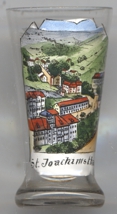
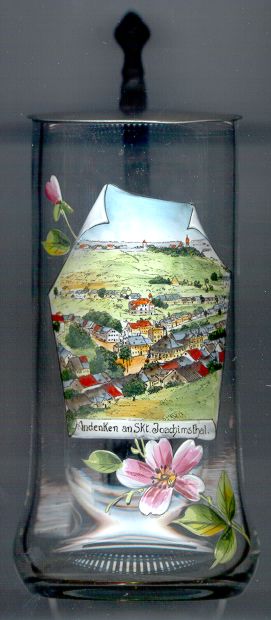 Jáchymov is situated at an elevation of 672 m in northern West Bohemia.
During the 15th century the area was important for silver and lead mining. The first settlement was called Konradsgrün.
A new town for miners who had been called in from Saxony was founded in 1516 and was called Thal, later Sankt Joachimsthal.
Already four years later, in 1520, the town received the status of a Free Mining Town. The rich deposits in silver were the main
source of the wealth of the town. The silver coins minted in Sankt Joachimsthal (first called 'Joachimsthaler', then simply 'Taler') became
one of the most successful coins in monetary history (even the word 'dollar' is derived from it). During the 16th century the town
was the second-most important town in Bohemia after Prague.
In the 18th century mining for bismuth, arsenic, lead and cobalt were the basis of a second
booming period. The world's first mining school was opened here in 1716. In the mid-19th century the first deposits of uranium were discovered
and made Austria one of the most important exporters of this mineral. Pierre Curie and Marie Curie-Skłodowska used the material for their
isolation and characterization of radium for which they received the Nobel Award for physics in 1903.
Jáchymov is situated at an elevation of 672 m in northern West Bohemia.
During the 15th century the area was important for silver and lead mining. The first settlement was called Konradsgrün.
A new town for miners who had been called in from Saxony was founded in 1516 and was called Thal, later Sankt Joachimsthal.
Already four years later, in 1520, the town received the status of a Free Mining Town. The rich deposits in silver were the main
source of the wealth of the town. The silver coins minted in Sankt Joachimsthal (first called 'Joachimsthaler', then simply 'Taler') became
one of the most successful coins in monetary history (even the word 'dollar' is derived from it). During the 16th century the town
was the second-most important town in Bohemia after Prague.
In the 18th century mining for bismuth, arsenic, lead and cobalt were the basis of a second
booming period. The world's first mining school was opened here in 1716. In the mid-19th century the first deposits of uranium were discovered
and made Austria one of the most important exporters of this mineral. Pierre Curie and Marie Curie-Skłodowska used the material for their
isolation and characterization of radium for which they received the Nobel Award for physics in 1903.
The first radium spa was opened in the town in 1901. The waters contain radon (10.5 kBq per litre) and are used for the treatment of inflammatory rheumatoid diseases, degenerative diseases, diseases of the peripheral nervous system, vascular and metabolic diseases.
The mining region of Jáchymov is part of the UNESCO World Cultural Heritage site Erzgebirge / Krušné hory (Ore Mountains) Mining Region, listed in 2019 and including, on the Czech side, the Krupka Mining Cultural Landscape, the Jáchymov Mining Landscape, the Abertamy – Boží Dar – Horní Blatná Mining Landscape, the Mining Landscape at the peak of Medník, and the Red Tower of Death in Vykmanov. (see also list of other UNESCO heritage sites depicted on glasses of this collection)
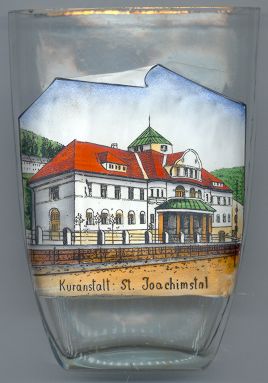
The  Kuranstalt or Kurhotel [left, no. 1382] was built in 1912.
Following a complete restoration it reopened in 1997.
Kuranstalt or Kurhotel [left, no. 1382] was built in 1912.
Following a complete restoration it reopened in 1997.
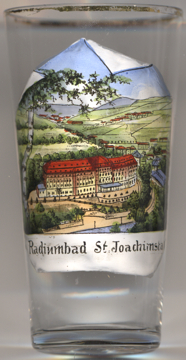
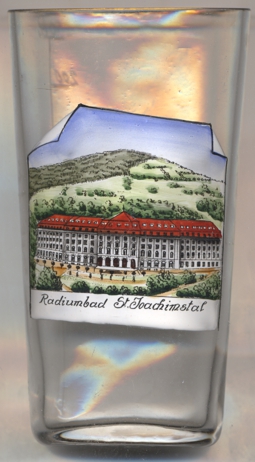
The  Hotel Radium Palace [near left, no. 3737, and right, no. 4208]
was built in 1912 in Classicist revival style. At the time it was one of the most modern spa hotels in
central Europe. A terrace and the balustrades were added after World War I. Modernisations and reconstructions
were carried out in 1995 and 1998. The hotel was renovated in 2017.
Hotel Radium Palace [near left, no. 3737, and right, no. 4208]
was built in 1912 in Classicist revival style. At the time it was one of the most modern spa hotels in
central Europe. A terrace and the balustrades were added after World War I. Modernisations and reconstructions
were carried out in 1995 and 1998. The hotel was renovated in 2017.
[https://www.fitreisen.de/kurhaus-radium-palace-st-joachimsthal-jachymov-westbohmen-h520/]
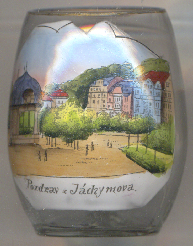
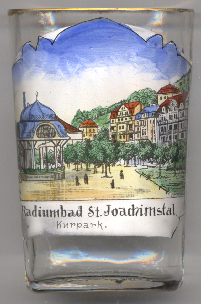
Glasses no. 4785 [left], no. 4822 [right] and no. 3142 [below] show a view of the spa with the
 music
music
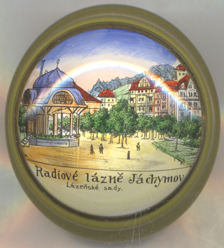
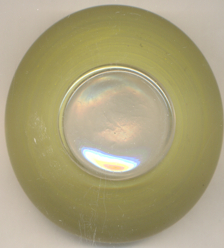
![[scale]](lineal.jpg)